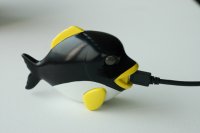Tux Droid… cool toy, or Tuxploitation?
Mar 30, 2007 — by LinuxDevices Staff — from the LinuxDevices Archive — 18 views A Belgian firm is shipping a wireless robot shaped like Tux, the Linux mascot. The KYSOH (Keep Your Sense of Humor) “Tux Droid” itself does not run Linux, however, leading some early observers to question whether the gadget exploits the Tux form factor unfairly.
A Belgian firm is shipping a wireless robot shaped like Tux, the Linux mascot. The KYSOH (Keep Your Sense of Humor) “Tux Droid” itself does not run Linux, however, leading some early observers to question whether the gadget exploits the Tux form factor unfairly.
(Click for larger view of Cyrus, the first Tux Droid)
 The Fish Dongle (Click to enlarge) |
“Tux-ploitation” or not, the Tux Droid appears to be a versatile gizmo based on a reprogrammable Atmel AVR microcontroller. It comes with a fish-shaped USB dongle named “Fux” (pictured at right), which controls Tux via a 2.4GHz full-duplex RF (radio frequency) link.
The Fux dongle creates three USB interfaces on the host PC: audio in and out, and a HID (human interface device) interface said to “transfer all commands to and from Tux.” An included “tuxdaemon” appears to offer a basic Python API (application programming interface) that Linux programmers can use to control the device. An available “Acapela Voices” program adds text-to-speech capabilities. For the truly hackerly, an included “special cable” allows reprogramming the Tux Droid's Atmel AVR microcontroller.
 Tux Droid (Click to enlarge) |
The Droid itself has three motors, including:
- One for eye and beak movement
- One for raising and lowering the wings
- One for spinning to the left or right
The Droid has a speaker for reproducing sounds sent from the computer or stored locally in 4Mbits of reprogrammable memory. The Droid also has a microphone, a headphone jack, and an audio in connector that outputs sound directly to the speaker.
The Droid has three pushbuttons, including one atop its head, and two integrated within the wing mechanics, “making pressure on the wings detectable,” KYOSH said. It also has two programmable blue LEDs behind its semi-transparent eyes. Finally, a light-dependent resistor enables the Droid to detect ambient light and/or movement in front of it, according to the company.
digg this story |
The Tux Droid has two external expansion interfaces. An I2C bus connector enables the attachment of additional sensors, such as temperature, humidity, pressure, and so on. And, an IrDA transceiver allows the device to be remotely controlled, or to control other IR enabled devices.
The Tux Droid is powered by a 750mAh NiCd battery pack with 4 AAA elements. A recharger appears to be included.
KYSOH cites typical Tux Droid uses that include:
- Let Tux Droid dance when you receive an email
- Program Tux Droid as a guard dog to scare away intruders
- Program Tux Droid as a wake-up clock
- Take Tux Droid to your bathroom to listen to the news broadcast
- Program Tux to be a remote control for your PC, activating multimedia applications
- Program Tux Droid to function as a wireless VOIP phone
- Or just show Tux Droid around to impress your buddies
Availability
The Tux Droid is available now, direct from KYSOH, priced at 79 Euros (approx. $105).
This article was originally published on LinuxDevices.com and has been donated to the open source community by QuinStreet Inc. Please visit LinuxToday.com for up-to-date news and articles about Linux and open source.